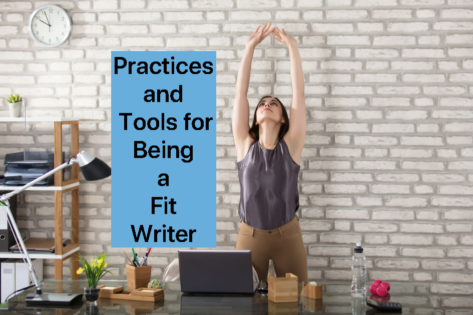 Are you comfortable when you write? Or do you have routine aches that distract you from writing? Six years ago, I began to examine more than just my writing abilities. I closely monitored my environment and the physical effects of my writing. Since then, these seven practices (or tools) have aided me in being a more capable (fit) writer.
Are you comfortable when you write? Or do you have routine aches that distract you from writing? Six years ago, I began to examine more than just my writing abilities. I closely monitored my environment and the physical effects of my writing. Since then, these seven practices (or tools) have aided me in being a more capable (fit) writer.
1. Use a desktop computer more often than a laptop.
Laptops are convenient, but they are not typically built for hours of daily use. When I use a laptop, I forget about my posture and don’t exhibit proper hand placement. Since I work from home and write for pleasure from home, my workstation is a personal computer. It has been better for my body and my focus. That leads me to number two.
2. Use a standing desk and change positions every hour.
I purchased a standing desk to sit on top of my flat desk. I noticed a difference in having less back pain and better posture within weeks of using mine. I have more energy because I’m not sitting down all day. I change positions every hour. The physical change helps me with that mental change I must make in my writing. I highly recommend getting one. This one is similar to what I have.
3. Pay attention to vision.
I began to look more closely at my monitor setup. My screen was at times too bright or dim. I was squinting. I pause now and adjust my settings to ensure I’m giving my eyes the best outcome. Sometimes my monitors move a little and I need to lift them. They should be placed at or slightly below eye level, approximately 20 inches away from your eyes, at an arm’s length distance. I increase the font size if it’s too small.
4. Use ergonomic recommendations for accessories.
When you do sit, are you using an ergonomic chair with a mesh back and plush seat cushion? My old chair was the cause of my back and lower body pain. I upgraded my entire workspace to be ergonomically friendly. I purchased memory foam mouse pads and keyboard cushions. These items may not seem important to your writing, but the right accessories make you settle in to focus because you’re more comfortable. They have made a big difference in my mood and how I feel physically.
5. Take short exercise and stretching breaks.
Since I tend to be more inactive when I write, I must commit to get up and move. That’s why I perform short exercise routines to give me a boost. I have several favorites on YouTube that I enjoy for five- or seven-minutes, such as BodyFit by Amy and Lucy Wyndham-Read. After a grueling, long assignment, my wrists and hands will hurt. So, I complete stretches targeted for the wrists and hands. Here is a three-minute stretch that helps ease pain. If you have more time, try this 12-minute video.
6. Use a refillable water bottle to meet recommended daily water intake.
To ensure I drink enough water, I use a refillable water bottle. I keep my special cup perched on my desk. By placing it near me, I am reminded to drink often. If I let myself become dehydrated, my energy level drops and I’m less productive. Drinking water makes me feel good and it helps me be more focused on writing tasks.
7. Set calendar reminders or use a smartwatch to perform steps 1-6 above.
I set reminders for the above practices. On my calendar every day at 6 a.m. and at noon I have a reminder to exercise. In addition, I check my monitor settings once a week. My smartwatch will remind me to move if it thinks I’m being too sedentary. It lets me know my step count too.
We writers want to write well. We should also feel well. The above writing tools and daily practices have helped me be more physically and mentally strong. I hope they will help you to be a fit writer too.

Lee Gramling
I guess the “wee dram” of Irish whiskey to get me started followed by the “bottomless coffee cup” don’t exactly make me a “fit” writer, but they seem to work for me.
Mandy Fernandez
Lee, if this is working for you, then you are a capable writer! 🙂 We all have the routines that help us.
But if you’re having aches, pains, or notice that your eyes, wrists, and back are bothering you at any point, then I hope you’ll try some of the tips or tools. Keep writing!
Peggy Lantz
I like your suggestions. Thanks.
Hi, Lee. I just do the coffee without the wee dram.
Mandy Fernandez
Thanks for reading and commenting Peggy. Let me know if you have any more tips that help you as a writer!
Rebecca Martell
Fantastic tips. Thanks, Mandy– I hadn’t considered adjusting the brightness of my monitor! I’ve also found that adjusting my chair to the correct height helps my desktop writing to be less fatiguing.
Happy writing!
Lee Gramling
Peggy: Yours is the only member’s name I recall from early in my career. But I’m afraid you’ll need to refresh my memory. Please contact me via email from the member’s list or my website.
FYI: The “wee dram” is 1 1/2 ounces and it’s the only time I take a drink. A bottle tends to last me several months.